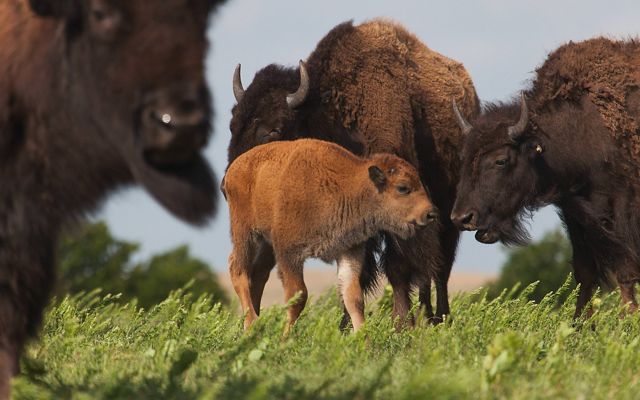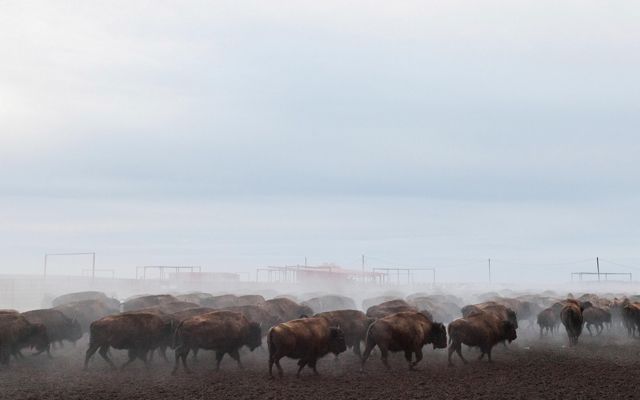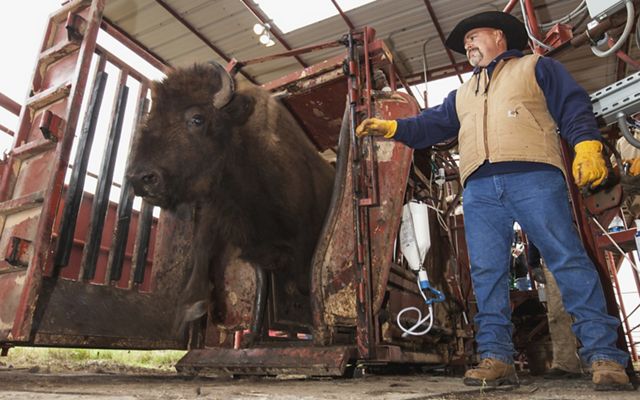A Shot in the Dark
Confronting the spread of a deadly disease among the bison at the Tallgrass Prairie Preserve may save herds across the country.
August/September 2015
A trio of flatbed pickups bump to a stop on a muddy paddock at The Nature Conservancy's Tallgrass Prairie Preserve in Northern Oklahoma. The rising sun is blinding on the horizon. Across the field, steam hangs over the furry landscape as the bison exhale puffs of vapor in the November chill.
The cowboys wait in their trucks for word that everything is ready back at the preserve’s headquarters. When they get the signal, the men will attempt to drive 200 skittish, half-ton bison through a narrow livestock gate into a corral on the west portion of the prairie. For now, it’s a waiting game: Everyone is quiet. Thermoses of coffee have been stowed away, their lids twisted on extra tight.
One of the young men breaks the tension with an old roundup joke: “You can herd a bison anywhere it wants to go.”
Then the call comes in over a cell phone to get started. The roar of engines cracks the morning quiet. And the trucks leap forward, marking the start of the fall bison roundup—an annual vet checkup and herd count, the 21st since the animals were reintroduced to the Tallgrass Prairie Preserve in 1993.
Spinning wheels kick up clods of dirt. Country music spills from open windows, accompanied by shouts of “Turn!” and “Yeehaw!” It looks like pure American-style chaos, but all the noise and action is needed to help drive the animals forward. Bison are not domesticated herd animals and are not easily corralled. Some animals try to break away from the group, but the trucks flank them and gradually turn the snorting tide into the corral. When the last hooves thunder through, preserve director Bob Hamilton quickly swings the barrier shut.
At the far end of the corral, workers wearing Carhartts and cowboy hats encourage the hulking animals down a fenced alley. They wave plastic rattles and hoot. The bison move in reluctant groups of 30 or 40 into a round enclosure and then are funneled one by one into narrow chutes. The animals have other plans, though. They buck and thrash and kick against the steel guardrails on their way to getting a checkup. Thick hides and thicker skulls help prevent injury, but the process still sounds like a multicar pileup.
Although Hamilton and his crew have been running fall roundups to assess the herd’s health and numbers since 1995, this one is very different. The bison started showing signs of respiratory distress in late 2013. Tissue samples found that they suffered from a lethal and poorly understood disease. It felt unfair that these animals, once almost extinct, should have to face another deadly hurdle. The outbreak forced Tallgrass’s staff to coordinate an emergency roundup and vaccination the following spring. Now, six months later, they will see if their medical intervention worked.

The story of the bison's near extinction is a familiar part of American frontier history: tens of millions slaughtered, often simply for sport. A survey by zoologist and conservationist William Temple Hornaday at the end of the 19th century found that only 1,091 of the animals remained in all of North America—most of them in captivity.
The Tallgrass Prairie Preserve is now home to the largest of 12 bison herds owned by the Conservancy on the Great Plains. The preserve keeps about 2,000 animals and has been a self-sustaining program for more than a decade.
Bringing bison back to prairies isn’t just an exercise in nostalgia. This wide-open grassy ecosystem developed for millennia under the influence of wildfires and large grazers. Maintaining a regimen of prescribed burns is necessary work, but preserve managers like Hamilton need the animals, too, because they are critical to a healthy prairie. Bison graze on living and dead plants, encouraging new grass growth and eliminating woody species that would otherwise take over. They’re more mobile than cattle and tend to graze in groups, all of which increases their effect on the landscape.
“We want the bison to be as wild as possible,” says Hamilton, who has been at Tallgrass since it opened, “and we want their impact on the ecosystem to be as wild as possible.”
“Bison are incredibly tough,” he adds. “They’re straight out of the Pleistocene.” Managing them as a herd is a relatively new endeavor for any ranch. So when preserve employees saw their animals losing weight and having trouble walking near the end of 2013—the herd’s 20th anniversary, as it happened—they knew something must be wrong. Then the bison started dropping dead.

Hamilton first suspected Anaplasmosis, a red blood cell parasite that had struck the herd before. But blood tests came back negative. He knew some of the bison ranches owned by media mogul and conservationist Ted Turner had been fighting a disease caused by Mycoplasma bovis. (Turner owns more bison than any other individual in the country.)
The bacterial pathogen has been a common problem in commercial cattle operations for decades, but is now usually controlled with a vaccine. To the dismay of Hamilton and other ranchers, strains of the dis-ease not found in cattle have recently started showing up in bison herds, where it is often fatal and not well understood.
When Cody Golay, the preserve’s veterinarian, got in touch with David Hunter, the veterinarian for Turner Enterprises, they agreed that the symptoms sounded like M. bovis: lethargy, arthritis, drastic weight loss and respiratory distress. But only a lung tissue sample would tell for sure. So, on a freezing day in January 2014, Tallgrass employees put down four females that looked closest to death. In three of them, one lung—normally 2 to 3 feet long—had atrophied and was smaller than a football. It was amazing the animals were still on their feet, Golay says. They sent samples for testing and the results confirmed the presence of M. bovis.
This may be a relatively new disease in the private bison-ranching business, but it is becoming a number-one concern, Hamilton says, even though researchers still don’t know exactly where it comes from or how it spreads. In less than 15 years, it has moved with surprising speed in bison herds across Canada and the United States, where it has killed up to a quarter of adults in a matter of months or even weeks. In one location, more than 45 percent of adult cows died, many leaving defenseless calves.
Hamilton had to act quickly. He immediately contacted bison ranches that interact with the preserve, warning them to be on the lookout for infection. Tallgrass employees started patrolling the herd every week.
Hamilton and Golay had heard about a new—and experimental—vaccine that had been developed for Turner’s herd in early 2014 and was being shared through the National Bison Association. But Karen Register, an expert on M. bovis in cattle with the Agriculture Department’s National Animal Disease Center, identified the Tallgrass version of the outbreak as yet another strain. It would take at least two months to develop a new custom vaccine, and the Tallgrass herd was getting sicker every week.
There was some hope: Register and Hunter both be-lieved the Tallgrass strain was genetically similar enough that the Turner vaccine might work. On the other hand, a spring roundup to vaccinate the herd would be hard on the animals, especially calves and mothers. “The more you have to chase bison, the more jacked up they get,” says Perry Collins, a Conservancy field steward. And stress helps M. bovis spread.
“It was a race against time and a gamble,” Hamilton says. “We had to decide: Watch more die or try to use this new vaccine? What’s the least worst option?” After consulting closely with Hunter and Register, Hamilton made the call to use the Turner vaccine. The first week in May 2014, they rounded up the Tallgrass herd to administer the shots.

Six months later, everyone at Tallgrass Prairie is anxious to see whether their plan worked. The bison have now settled down. The gates of the single-file chute slide aside to admit the animals one by one into the squeeze chute, where Collins operates a pair of hydraulic panels that press in from the sides and immobilize each animal. He’s joined by Hamilton, Golay, and two or three others. They work in a tight, careful routine; even a restrained bison can cause serious damage to itself and anyone nearby. The animal is identified, weighed and given any vaccinations it needs, including a booster against M. bovis. The process usually takes less than a minute per animal, and is repeated 400 to 500 times on each of the six days of the roundup.
When the animal’s checkup is complete, everyone steps back, the chute opens and the bison bounds forward in an explosion of indignity. Automatic gates guide it into one of two paddocks, based on whether it’s being kept or sold. Calves are even less inclined to cooperate than their parents, but when it’s all over, mama is waiting at the end of the run.
Collins says the animals seem to be doing much better than in the spring, when some females were down by several hundred pounds. There’s none of the stiffness, weakness or coughing in the chutes that plagued the animals a few months ago. Calving rates are down, as expected with so many females sick in the spring. But average weights are back within normal ranges compared with other fall roundups.
The best news is how many adult bison died since May: none. “Not to lose any adults, that’s a happy face,” Hamilton says. “That’s a good sign we think the vaccine’s working.” But nobody at Tallgrass is celebrating yet. Hamilton says it could be several years before the herd is truly out of the woods. Two critical indicators will be how many animals survived last winter and the number of calves born in the spring. Those data will be available only after the fall 2015 roundup. Since the vaccine doesn’t eliminate M. bovis from the host, it will likely become one of the herd’s yearly inoculations. Hamilton credits all the partners who lent their expertise and helped the preserve avoid a much larger disaster.
Even with so much still unknown about M. bovis in bison, the experience gained at Tallgrass may help protect bison herds across the country, says Hamilton. The staff learned that when severe disease outbreaks occur, the earlier you can take action, the better. “You’ve got to move quickly on these things,” he says. Also, the practice of leaving the animals alone as much as possible did make it a challenge to gather the animals quickly in the off-season. Lastly, using vaccine-laced darts seemed to work well as an alternative inoculation system for the bison that evaded the emergency roundup.
Hamilton thinks these lessons in turn will help other herd and prairie stewards restore the shrunken habitat—some-thing in which humans have to take an active role, since we’ve altered it so drastically. The glory days of the roaming bison and open prairies may be gone. But people at places like Tallgrass are trying to restore the ecosystem by mimicking the ancient cycles of migrating herds and wildfire.
“Now, we are the lightning, we are the wolves,” Hamilton says. “We’re the new torch carriers."
